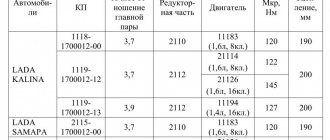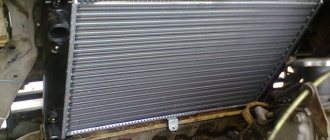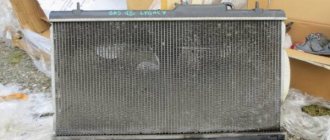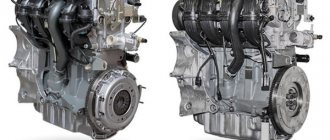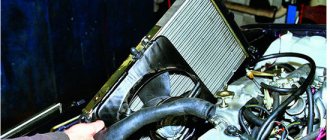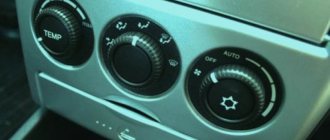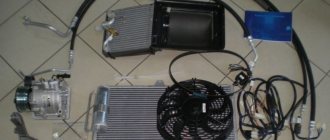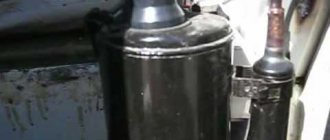Radiator leaking on Priora? Don't know what radiator you need? In this article we will briefly describe how to choose the right radiator for a VAZ 2170.
In total, Priora can have up to three radiators:
1) engine cooling radiator,
2) air conditioner radiator (condenser),
3) heater radiator or stove radiator.
Let's talk about the main engine cooling radiator. When selecting, you need to check whether your car has an air conditioner, since in a Priora with air conditioning, an air conditioning radiator is additionally installed, so the engine radiator is made thinner and with different mounts. This entails an increase in its price due to a more complex design, since with a smaller size it is necessary to achieve the same heat transfer.
So, if you need an engine radiator for a VAZ 2170 Priora 2007 to 2016 without air conditioning, then you need a radiator with catalog number 2170-1301012, CORE SIZE, MM: 560*340*34. The LUZAR company (St. Petersburg) produces a high-quality analogue of this radiator with a 2-year guarantee CODE LUZAR LRc 0127. Click to buy a radiator for Priora without air conditioning available in Orenburg.
If you need to replace the radiator on a VAZ 2170 Priora with air conditioning, you should check which air conditioner you have: PANASONIC or HALLA.
This can be done by knowing their differences. Here are some of them:
1) the Panasonic system’s blower speed selection knob has about 16 positions, which provides fewer steps than Halla’s, which has 4 speeds.
2) under the hood, the Hall system lines are aluminum, while Panasonic’s upper line is a flexible black hose (the line is located to the left of the engine protective cover).
If you have a Halla air conditioner, then you need an engine radiator CORE SIZE, MM: 560*340*26. The LUZAR company (St. Petersburg) produces a high-quality analogue of this radiator with a 2-year guarantee CODE LUZAR LRc 01270b. Click to buy a radiator for Priora with Halla air conditioner available in Orenburg.
If you have a Panasonic air conditioner, then you need an engine radiator CORE SIZE, MM: 560*340*26. The LUZAR company (St. Petersburg) produces a high-quality analogue of this radiator with a 2-year guarantee CODE LUZAR LRc 01272b. Click to buy a radiator for a Priora with Panasonic air conditioning in stock in Orenburg.
Accordingly, the air conditioner radiators in these cases are also different.
The use of various climate systems in the Priora VAZ 2170 necessitated the use of various heater radiators (stoves).
Still have questions? Do you want to order free delivery of a radiator by courier in Orenburg? Call (3532)28-12-88
Pick up radiators at your own expense from our warehouse on the street. Shosseynaya 24a, 2nd floor, office 213 (BC Navigator).
Do you think that the air conditioner does not cool the interior enough in hot weather, does not cope with its task 100% and the air coming from the air ducts is not as cold as you would like? Do not rush to seek help from specialists; first check the efficiency of the air conditioner yourself.
How to find out how much air conditioning costs on a Priora
Of the minuses: in 40 degree heat the interior takes a long time to cool down,
What about the Panas, does the interior cool down faster?
Of the minuses: in 40 degree heat the interior takes a long time to cool down,
What about the Panas, does the interior cool down faster?
And the interior cools down equally. You can simply use the air conditioner correctly (as it is written in the manual), or you can use it not quite correctly. The result will be somewhat different.
It is quite difficult to say which system is UNIQUELY better. HALLA - easier and cheaper to maintain and repair PANASONIK - more convenient to use And then everyone thinks about why he is buying a car - to repair it or to use it.
I repeat once again: apparently at AvtoVAZ there is confusion with two Panasonics for Kalina and Priora and the system is under-filled on Prioras. If you think that your Panas does not freeze well, check the amount of refrigerant. It should be up to 650 grams, and not up to 450, as on the sticker under the hood.
“Dual zone”. Yes, there is an effect, but personally it somehow doesn’t bother me, since the temperature in the cabin is always set at an almost constant temperature of 18 degrees and climate control comes down to periodically turning on the “windshield drying” mode. After reading multiple complaints about this effect here, I began to specifically monitor it. Happens. Rarely. Not much. It goes away on its own. The more often you change the temperature settings, the more often the effect appears. Those. it is somehow connected precisely with the change in temperature settings.
I can judge Halla’s shortcomings only because the topic about Halla’s problems here is longer than about Panasonic’s problems.
Which one puts less stress on the engine? About the same. Halla has a piston compressor, Panas has a rotary compressor. Halla's design is more advanced and therefore more reliable.
Today I was at the service (I did some service work). At the next post the machine was being repaired with Halla. It's a shame that because of a couple of resistances, the entire heater was removed and replaced as an assembly. I asked the craftsmen about the reliability of both systems. We couldn’t say for sure, it seems that Panasonic was repaired more often
I can speak for HALLA on my car: The load is felt at low speeds. At rpms over 3000 there is no difference in thrust.
I didn’t read the whole topic, sorry if such information came up) In the stock firmware it is programmed under what conditions the air conditioner is turned off and on (be it speed, or how open the remote control is)
PS Near Hull itself, it cools quickly and coldly), the auto mode works well, all summer the temperature was set to slightly less than half (on the TEMP knob)
I have Panas, never in the heat. As I understand it, problems with the performance of Panasonics are associated with insufficient refrigerant. Panasonics put on Kalina and Priora. For the most part, these are interchangeable systems, but the volume of refrigerant in Kalina is 450 g, and in Priora – 650 g. But on the conveyor they pour 450 grams. +/-. It’s worth filling in at least 550 - and it’s already quite cool (28 on the street, 11 were blowing from the nozzles before the engine overheated and wanted even less. But I didn’t dare to fill something with 650 g.).
Halla goes, as I understand it, only to Priora. And it’s simply impossible to confuse the filling volume.
I repeat once again: Halla is easier and cheaper to repair and maintain. Panasonic is more convenient to use. If you have the opportunity to choose a climate, then proceed from this, i.e. What is more important to you – convenience or maintainability (in this case, keep in mind that Halla’s cabin temperature sensor is original, while Panasonic’s is the same as the standard one).
By the way, under warranty, both systems are repaired in the same way - by replacing the assembly.
As for the “two-zone” (cold air into the left nozzles on the dashboard, hot air into the right nozzles) of Panasonic, I specifically observed this interesting phenomenon. Conclusions: 1. Present. 2. Usually occurs after changing the temperature settings 3. When the temperature in the cabin is equalized, it disappears 4. The temperature difference is from noticeable to barely perceptible 5. It goes away on its own if the climate is not forced. 6. With normal refrigerant charging, it tends to disappear completely.
As I understand it, problems with the performance of Panasonics are associated with insufficient refrigerant. Panasonics put on Kalina and Priora. For the most part, these are interchangeable systems, but the volume of refrigerant in Kalina is 450 g, and in Priora – 650 g. But on the conveyor they pour 450 grams. +/-. It’s worth filling in at least 550 - and it’s already quite cool (28 on the street, 11 were blowing from the nozzles before the engine overheated and wanted even less. But I didn’t dare to fill something with 650 g.).
About the volume of refrigerant filling into the Panasonic system on a Priora: from the moment of purchasing the car, I was constantly tormented by “plugs” in the system (the evaporator froze after 1.5 hours of driving with air conditioning) mainly when driving on the highway (in the city, trips longer than an hour are rare). Periodically there was no condensation (it simply froze on the evaporator along the way) and appeared in large quantities after the air conditioner was turned off. The diagnostics showed nothing - the pressure in the system is normal, the sensors are in order. There was no way to get the system with the “plug” to the service station and, in general, I stopped at the service station and simply asked to refill the system at my own expense. When pumping out freon, it was discovered that there were 600 grams of refrigerant in the system (and this was after the third summer of using the air conditioner). As a result, we filled the system with 470 grams of freon and the problem of “plugs” disappeared, condensate now flows like birch sap in the spring, and now the engine strains much less when the air conditioner is running and the fans do not thresh so often at second speed.
Air conditioning not working? Problems and solutions
When summer comes, you want your air conditioner to run without a hitch, and even the best air conditioners can develop problems over time. So, what should you do if your central AC unit is not working properly? Don't worry. Sears Home Services heating, ventilation and air conditioning (HVAC) technicians can troubleshoot your air conditioner to get it running smoothly again. Use this air conditioning (AC) troubleshooting list to help you identify some common air conditioning problems and find solutions.
Air conditioner is not cooling
The air conditioner does not allow cold air to pass through
If your air conditioning system turns on but doesn't blow out cool air, make sure all vents are open and the thermostat is set correctly. If this is not the problem, check the air filter. If it's clogged with dirt or other debris, you won't get any airflow. Since clogs can cause the evaporator coils to freeze, ice and frost will further clog the airflow. In this case, clean the filter with a soft brush, mild soap and water. Clean and replace the filter frequently to avoid this problem in the future. You may also have a problem with the fan or fan motor. If the fan turns easily, you may have problems with the power supply to the motor or a leak in the refrigerant line. In such cases, you will likely need a qualified HVAC technician to inspect the unit.
Air conditioner is not cooling enough
Check the vents to make sure they are all open. If at least one of them is closed, it can make it difficult to cool your entire home, since warm air from the room with the closed vent will mix with cooled air from the others. Otherwise, you may have another problem, such as a leak in the refrigerant line. If your system is old or was installed incorrectly, it may be wearing out or may not be the right size for your home. Systems that are too large for your home will turn on and off too quickly, reducing their efficiency. A system that is too small for your home will have a harder time cooling your home, causing premature failure.
Air conditioner leaking water
Air conditioner leaking water
To avoid costly water damage, turn off your air conditioner if it leaks in your home. The condensation drain line may become clogged, causing water to back up into your home. DIYers can try using a wet/dry vacuum to clear the line. If this doesn't work, your drain pan may be rusty or your condensate pump may be broken. Your technician will be able to replace or repair damaged parts.
Air conditioner leaking water
On hot or humid days, you may see a small puddle of water under the condenser. In hot, humid weather, this is normal as long as it only forms when the unit is running. In cool weather—usually 60 degrees or below—the air conditioner may freeze, causing water to leak when it melts, which is also normal. If it leaks under other circumstances, try cleaning or replacing the air filters. If this does not resolve the issue, schedule a support call. You may need more refrigerant, there is a clog in the drain pipe, or the condensate pan is broken.
Water leaks from the air conditioner when turned off
If your system is low on refrigerant or has a dirty filter, the system may freeze while running. Once turned off, the ice melts and water leaks out. Don't risk water leaking from your air conditioner onto the floor or ceiling. If cleaning the filter does not help, do not turn on the air conditioning system again until you find and fix the problem. As with external leaks, you may have a clogged or broken condensate pan.
Air conditioner won't turn off
The air conditioner won't stop working
If your air conditioner is left on longer than it should, you may have a dirty filter. Clean or replace the filter to see if that helps fix the situation. If your system is outdated or the wrong size, it can also cause the system to work too hard, run too often, and be difficult to shut down. Other problems that can cause your AC to run constantly include:
- Fan relay stuck
- Short circuit in thermostat cable
- The thermostat has failed
Central air conditioner won't turn on
If your central air system won't turn on, it may be as simple as adjusting the thermostat. If this doesn't work, call a technician as your HVAC system may need to be repaired or replaced.
Window AC unit not working
Likewise, with a window unit, you should first check the temperature setting on the unit and ensure that electrical current is flowing into the system. Again, if none of these troubleshooting efforts reveal the problem, seek professional help to repair your window AC unit.
AC fan does not work
AC fan not working inside
If your indoor AC fan isn't working, first check to see if the breaker has tripped. If it's OK, check the air filter. If it is blocked, you may be able to fix it yourself. If there is ice on the evaporator coil and refrigerant lines, let the ice melt and then check again to see if the fan is working. If it doesn't work, your coil may be frozen. A frozen coil requires a service call because your technician may need to replace the contacts inside the fan relay, the fan belt, or even the motor itself.
AC fan does not work outside
If your air conditioner is not cooling properly, you may want to check the outdoor unit. If the outdoor fan is not spinning, check your circuit breaker or fuse box first. If resetting doesn't solve the problem, there may be more than one issue at play.
- Start capacitor not working: If the compressor is still running, the fan motor or start capacitor may not be working. You can try to fix this by pushing the fan with a wooden stick. Do not do this manually, as if the fan does start, it may cut your fingers. If it still does not start spinning, you will need to call a local technician. Turn off your device until he or she arrives. If you don't do this, you risk burning out the compressor - a serious repair.
- Outdoor Fan Motor Stuck: The fan could be stuck due to dirt or rust. If the unit requires more extensive repairs, you may need to repair or replace the outdoor fan motor.
Once you have your air conditioning system repaired, make sure to visit your local Sears air conditioning technician annually for an inspection. With regular maintenance, your system will last longer, operate more efficiently, and save you money on your energy bills in the long run. You can't go wrong with the air conditioning experts here at Sears Home Services. We are here for your home.
.
How to find out how much air conditioning costs on a Priora
Of the minuses: in 40 degree heat the interior takes a long time to cool down,
What about the Panas, does the interior cool down faster?
Of the minuses: in 40 degree heat the interior takes a long time to cool down,
What about the Panas, does the interior cool down faster?
And the interior cools down equally. You can simply use the air conditioner correctly (as it is written in the manual), or you can use it not quite correctly. The result will be somewhat different.
It is quite difficult to say which system is UNIQUELY better. HALLA - easier and cheaper to maintain and repair PANASONIK - more convenient to use And then everyone thinks about why he is buying a car - to repair it or to use it.
I repeat once again: apparently at AvtoVAZ there is confusion with two Panasonics for Kalina and Priora and the system is under-filled on Prioras. If you think that your Panas does not freeze well, check the amount of refrigerant. It should be up to 650 grams, and not up to 450, as on the sticker under the hood.
“Dual zone”. Yes, there is an effect, but personally it somehow doesn’t bother me, since the temperature in the cabin is always set at an almost constant temperature of 18 degrees and climate control comes down to periodically turning on the “windshield drying” mode. After reading multiple complaints about this effect here, I began to specifically monitor it. Happens. Rarely. Not much. It goes away on its own. The more often you change the temperature settings, the more often the effect appears. Those. it is somehow connected precisely with the change in temperature settings.
I can judge Halla’s shortcomings only because the topic about Halla’s problems here is longer than about Panasonic’s problems.
Which one puts less stress on the engine? About the same. Halla has a piston compressor, Panas has a rotary compressor. Halla's design is more advanced and therefore more reliable.
Today I was at the service (I did some service work). At the next post the machine was being repaired with Halla. It's a shame that because of a couple of resistances, the entire heater was removed and replaced as an assembly. I asked the craftsmen about the reliability of both systems. We couldn’t say for sure, it seems that Panasonic was repaired more often
I can speak for HALLA on my car: The load is felt at low speeds. At rpms over 3000 there is no difference in thrust.
I didn’t read the whole topic, sorry if such information came up) In the stock firmware it is programmed under what conditions the air conditioner is turned off and on (be it speed, or how open the remote control is)
PS Near Hull itself, it cools quickly and coldly), the auto mode works well, all summer the temperature was set to slightly less than half (on the TEMP knob)
I have Panas, never in the heat. As I understand it, problems with the performance of Panasonics are associated with insufficient refrigerant. Panasonics put on Kalina and Priora. For the most part, these are interchangeable systems, but the volume of refrigerant in Kalina is 450 g, and in Priora – 650 g. But on the conveyor they pour 450 grams. +/-. It’s worth filling in at least 550 - and it’s already quite cool (28 on the street, 11 were blowing from the nozzles before the engine overheated and wanted even less. But I didn’t dare to fill something with 650 g.).
Halla goes, as I understand it, only to Priora. And it’s simply impossible to confuse the filling volume.
I repeat once again: Halla is easier and cheaper to repair and maintain. Panasonic is more convenient to use. If you have the opportunity to choose a climate, then proceed from this, i.e. What is more important to you – convenience or maintainability (in this case, keep in mind that Halla’s cabin temperature sensor is original, while Panasonic’s is the same as the standard one).
By the way, under warranty, both systems are repaired in the same way - by replacing the assembly.
As for the “two-zone” (cold air into the left nozzles on the dashboard, hot air into the right nozzles) of Panasonic, I specifically observed this interesting phenomenon. Conclusions: 1. Present. 2. Usually occurs after changing the temperature settings 3. When the temperature in the cabin is equalized, it disappears 4. The temperature difference is from noticeable to barely perceptible 5. It goes away on its own if the climate is not forced. 6. With normal refrigerant charging, it tends to disappear completely.
As I understand it, problems with the performance of Panasonics are associated with insufficient refrigerant. Panasonics put on Kalina and Priora. For the most part, these are interchangeable systems, but the volume of refrigerant in Kalina is 450 g, and in Priora – 650 g. But on the conveyor they pour 450 grams. +/-. It’s worth filling in at least 550 - and it’s already quite cool (28 on the street, 11 were blowing from the nozzles before the engine overheated and wanted even less. But I didn’t dare to fill something with 650 g.).
About the volume of refrigerant filling into the Panasonic system on a Priora: from the moment of purchasing the car, I was constantly tormented by “plugs” in the system (the evaporator froze after 1.5 hours of driving with air conditioning) mainly when driving on the highway (in the city, trips longer than an hour are rare). Periodically there was no condensation (it simply froze on the evaporator along the way) and appeared in large quantities after the air conditioner was turned off. The diagnostics showed nothing - the pressure in the system is normal, the sensors are in order. There was no way to get the system with the “plug” to the service station and, in general, I stopped at the service station and simply asked to refill the system at my own expense. When pumping out freon, it was discovered that there were 600 grams of refrigerant in the system (and this was after the third summer of using the air conditioner). As a result, we filled the system with 470 grams of freon and the problem of “plugs” disappeared, condensate now flows like birch sap in the spring, and now the engine strains much less when the air conditioner is running and the fans do not thresh so often at second speed.
see also
TOP 5 cabin filters according to PartReview
Which cabin filter is better?
Cabin filter
Replacing the cabin filter Lada Priora
Lada Priora is a very popular car, and it’s not for nothing that it was produced in Russia for about 10 years. And when a lot of machines are produced, then there are many modifications, and there may be several suppliers of attachments, which leads to differences in design. This explains why the cabin filter on the Lada Priora is a part that has three versions:
- Cabin filter for Priora with Halla air conditioning;
- Cabin filter on a Priora with Panasonic air conditioning;
- Cabin filter if “Priora” without air conditioning.
All three versions of the part have different designs and dimensions. Also, filters for cars with and without air conditioning differ in their installation location. And in the dealer network for the secondary market, not only regular versions of the original filters are available, but also carbon ones. From the factory, of course, they are standard. So what kind of cabin filter do you have on your Priora? Let's figure it out.
Air Conditioner Installation Guide
Before you complete this task, you need to decide which option you will use. There are quite a lot of manufacturers of air conditioning units on the market today, so the purchased unit must meet the requirements and characteristics of the car. The device must have a long service life, resistant to vibrations that are typical for cars used to drive on our roads. It's no secret that our car enthusiasts are more inclined to trust Conder cars and products in general from foreign manufacturers.
How to connect an air conditioner to a Priora with power steering
If we talk about foreign installations, here you can choose Panasonic, Halla or any other system. As for domestic manufacturers, according to reviews, the August air conditioner has proven itself well.
The installation kit should include:
- cooling radiator or air conditioning radiator;
- the installation itself, which includes the Priora air conditioning compressor;
- tension roller bracket;
- highways.
Heating device for Hull installation
If we talk about the domestic product, then in this case the only drawback can be called the evaporator housing, since it is plastic, which raises some doubts. There is a possibility that the compressor will fail before other elements. In any case, you need to choose a manufacturer in accordance with the reviews that our car enthusiasts leave online.
Installing an air conditioning system involves removing the heating system, which first requires dismantling the air filter housing and draining the coolant. Next, the front bumper is dismantled. After removing the components, you can begin to remove the generator. The kit for the installed air conditioner must include a separate generator designed for a specific car. So you need to install the device instead of the old one.
First of all, you need to install supports on which the unit’s compressor, as well as the generator, will be mounted. Next, you should fix the tension roller installation bracket. To mount the roller bracket, you may need to drill a hole in the strap cover, after which the oven housings and the evaporation device are connected to each other. Next, on a Priora with air conditioning, you should install a compressor, radiator, and fan. After installing the components, including the roller, all elements must be included in the wiring diagram.
Scheme of operation of a foreign-made air conditioner Frost
If you choose a Russian-made unit, please note that it does not include a cabin air filter element. Therefore, you will have to isolate the electric motor in the cooling system yourself. If you notice that the unit does not turn on, you may need to refuel it, which, in turn, involves dismantling the radiator. Of course, in this case we are talking about Russian-made Conders.
If you notice that the air conditioner is not working, this does not necessarily indicate that the unit is not working. Perhaps the compressor is overheating, or perhaps the bearing simply needs to be replaced. In any case, you should not immediately think that the manufacturer is to blame - you need to diagnose all elements of the cooling system.
How to Find an Air Conditioner Leak in Less Than 15 Minutes
Is there a freon leak in the air conditioner? If your system is too trickle charging or if the system is flat, you have a leak that needs to be found. This guide will show you how to find a refrigerant leak. There are several ways to find a leak, which depends on how big the leak is. If the leak occurs relatively quickly, you should hear it leaking very heavily. like a hole in a tire that is easy to find. Large leaks are usually caused by a blown hose or a frayed line on the frame or bracket in the engine bay.
Here's a video that will give you an idea of what you're in for when checking for leaks. When you finish watching the video, continue with the guide, which will give you more tips and updated information regularly.
SPONSORED LINKS
There is an alternative way to find leaks without using a leak detector. With the air conditioning system fully charged, have a spray bottle of water with a heavy soap solution ready. Then spray the product around the various components and when a leak is detected, bubbles will begin to appear indicating a leak. This method works well except for the compressor front seal and evaporator leak detection.
Additionally, some freon products contain dyes that, when installed in the system, will be detected by a black light, but again the front compressor seal and evaporator leak are difficult to detect.
A slow leak can be difficult to detect, most of the time you can visually see a slow leak due to oil stuck in the system along with the refrigerant that is leaking from. An oil leak indicates where the leak is located. Look at all refrigerant lines, compressor and condenser for signs of leakage. See example below:
The method below is the preferred way to find a leak.
SPONSORED LINKS
Step 1: Use a Leak Detector
If you don't hear a leak or detect any oil residue, then a detector is necessary. If you don't have a detector, you can buy one from Amazon for about $35. The detector consists of a main body that holds the sensing element, batteries, a switch and sensitivity controls. Here's what they typically look like in the image below.
At the end of the detector is a “sniffer” that extracts a small amount of air to analyze for traces of refrigerant when turned on.
Step 2: Check the system for leaks
Before testing begins, the system must be filled with freon so that the detector can do its job. If the system is flat or very low, the detector needs to be sniffed. In addition, the engine must be turned off and the vehicle must be in a place where there is no wind or breeze. Any air movement can push the freon away from the actual leak and give you a false reading or make detection more difficult. Another thing worth mentioning is that refrigerant is heavier than air, so try checking below or the bottom of the object for leaks.
SPONSORED LINKS
Dust and dirt can cause the detector to falsely "fire" and it can trick you into thinking there is a leak when in fact there isn't. If you do this, accidentally catch some dust in the detector tip and the detector will reset itself. Keep the nozzle away from vehicle dirt as much as possible.
Turn on the detector and set the sensitivity to minimum to begin testing. Here we are testing the O-ring on the receiving dryer with no response from the detector. O-rings are popular places to look for leaks. The Tester will indicate a leak by showing one or more red lights while beeping. If you have tested the entire system and no leaks are found, adjust the sensitivity to a higher value.
The pressure sensor for the system is also a popular place to look; check the base and electrical connector for leaks.
The condenser, located at the front of the vehicle, is subject to small stones and other road debris, which are easy to damage and leak. Check the entire condenser, including the hose connections.
SPONSORED LINKS
At the front of the compressor is the main shaft seal and a very popular location for freon leaks. You want to place the sniffer at the very front of the compressor and at the bottom of the coupling. Again, be careful not to get dirt into the nose of the detector.
The system's hose fittings look like this: This is an inverted hose barb that holds the rubber hose to the aluminum fitting or tube. Test at the bottom of the connection.
Here is a method to check the system's evaporator. Locate the water drain and insert the detector if a leak is detected. The evaporator core or the o-rings that connect it to the high and low pressure side hoses are leaking. This drain allows condensation that drips from the evaporator when it is in use and directs it away from the vehicle's interior. Do not allow water to enter the nose of the sniffer.
Have you ever seen ordinary water under your car? when does the air conditioner work or was it working? That's where it drains from.
Also when the car has regular water on the passenger side when the air conditioning is in use this tube is clogged preventing water from draining out. Use compressed air and blow out the drain to fix the problem. use a wire and insert it into the drain to remove the blockage.
SPONSORED LINKS
When the detector detects a leak, it will indicate this by quickly beeping and turning on the red lights on the detector. The system now needs to be discharged and the line removed and replaced. After the repair is completed, the system must be evacuated and recharged.
You should also be interested in:
If there are questions you would like to ask, please do so, our community of mechanics will happily help.
SPONSORED LINKS
Article published 06/11/2018
.
Installation of foreign-made climate systems
Lada Priora air conditioner "August" is one of the most inexpensive options. If you want to buy a higher quality device, then you can opt for the Hull, Panasonic or Frost systems. In practice, the latest model is characterized by good compatibility with the Priora heating system, due to which the air flow filtration will be of better quality. As for the installation scheme, it is practically no different (the author of the video is Auto World).
But Frost also has its drawbacks: it happens that the installation gets very hot, does not cool the air well, and generally does not cope well with its assigned functions. But even if the unit works well, it will take longer to cool the interior. This is because the compressor itself is not particularly powerful. But despite the disadvantages, Frost also has advantages. When the air conditioning is turned on, it will generally not affect the functionality of the vehicle.
It should also be noted that the air conditioning units of this manufacturer were tested in African countries, and this says a lot. In particular, during testing, the installation cooled the interior well, while the engine of cars of various brands did not overheat. On sale you can find several variants of Frost condensers, which differ from each other only in the installation method. When installing the device, you will need to remove the heating system damper, but this will allow you to install an air filter, which is no less important.
In any case, when purchasing, you should focus on your preferences, as well as your budget. If the device gets very hot, you need to pay attention to diagnosing all its components and components. As a rule, this problem is caused by the need to replace the radiator. In addition, during operation, one should not forget about refueling the system, as well as its periodic cleaning. We have already written in more detail about how to clean the air conditioner on your own using improvised means; you will find information about this here.
About refilling the air conditioner
You need to pump 500 g of refrigerant into the Priora air conditioner. Until 1995, R12 freon was pumped into air conditioners, but it was considered toxic due to its high fluorine content. Therefore, R134A freon is now in use. Preparing for refueling looks like this:
- special cleaning foam from a can is pumped into the air conditioner radiator;
- the radiator closes. The car engine starts and idles. At the same time, the air conditioner turns on. It must run for at least 15 minutes so that the foam passes through the entire recirculation system;
- vacuum is performed. A pump is connected to the air conditioner, which removes air from the system along with foam and moisture.
Refueling
To refill the air conditioner, the driver must purchase a metrology station and a can of freon.
High pressure hoses in the station are always red, low pressure hoses are always blue
The station is a system of hoses, adapters and pressure gauges connected to the air conditioner.
- The station hose is connected to the low pressure fitting on the air conditioner pipeline (it is usually painted blue or has the English designation “low”).
Tube fittings are usually marked “high” and “low” - The engine starts and idles, and the number of revolutions per minute should not be lower than 1400 (for this you will have to fix the gas pedal with something, or ask someone for help).
- When the engine is running, maximum recirculation of the air conditioner is turned on, then the low pressure valve at the station smoothly opens.
- The freon cylinder is turned upside down, after which the tap is opened on it.
- The refrigerant begins to flow from the cylinder into the system. At the same time, the driver controls the pressure using a pressure gauge - it should not exceed 280 kPa.
- When the air in the cabin warms up to a temperature of 10–15°C, refueling stops.
Video: how to refill the air conditioner
Why does Priora have air conditioning?
Before you find out how to install a cooling system with a control unit in accordance with the electrical diagram and whether this is possible, let's understand its purpose. Today, buying a Priora with a climate control system is not a particularly cheap pleasure. Therefore, many owners decide to equip their car with Halla, Panasonic or another climate system. Installing an air conditioner in any case is a reasonable decision if the driver wants to achieve comfort when driving a vehicle.
All elements for the air conditioning system of Lada Priora
Moreover, the air conditioning on the Priora will subsequently affect the cost of the car when sold. And if you consider that many motorists today change their cars quite often, this seems quite advisable. Installing a climate control unit with your own hands (Hall, Panasonic) with a coupling, rollers, all pipes, pressure sensors, an air conditioner fan and other elements will not only cool the interior. With proper installation of the electrical circuit, it is possible to ensure that the switched on operating station will cool the motor when it warms up. Currently, such an installation is indispensable, especially when operating a vehicle in the heat.
